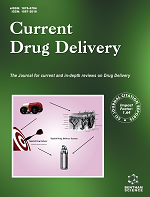- Home
- A-Z Publications
- Current Drug Delivery
- Previous Issues
- Volume 19, Issue 10, 2022
Current Drug Delivery - Volume 19, Issue 10, 2022
Volume 19, Issue 10, 2022
-
-
Inorganic-organic Synergy in Nano-hybrids Makes a New Class of Drug with Targeted Delivery: Glutamate Functionalization of Iron Nanoparticles for Potential Bone Marrow Delivery and X-ray Dynamic Therapy
More LessThe direct delivery of therapeutic molecules is generally inefficient and has several problems. Hence, nanomedicines with targeted and controlled delivery applications have been an exciting field of research for the past decade. In this regard, the adjustable properties of inorganic nanoparticles like particle size distribution, ability to change the targeting ligand to have a higher affinity towards the pathologic cell, and controlled del Read More
-
-
-
Functionalized Nanostructured Bioactive Carriers: Nanoliposomes, Quantum Dots, Tocosome, and Theranostic Approach
More LessBackground: Lipid nanocarriers have great potential for the encapsulation and delivery of numerous bioactive compounds. They have demonstrated significant benefits over traditional disease management and conventional therapy. The benefits associated with the particular properties of lipid nanocarriers include site-specific drug deposition, improved pharmacokinetics and pharmacodynamics, enhanced inte Read More
-
-
-
Lipid-based Nanoparticles for the Targeted Delivery of Anticancer Drugs: A Review
More LessCancer is one of the leading causes of mortality worldwide. Although chemotherapeutic agents have been effectively designed to increase the survival rates of some patients, the designed chemotherapeutic agents necessarily deliver toxic chemotherapeutic drugs to healthy tissues, resulting in serious side effects. Cancer cells can often acquire drug resistance after repeatedly administering current chemotherapeutic Read More
-
-
-
Current Status of In vitro Models of the Blood-brain Barrier
More LessAuthors: Brijesh Shah and Xiaowei DongDisorders of the brain constitute the most debilitating situation globally with increased mortality rates every year, while brain physiology and cumbersome drug development processes exacerbate this. Although blood-brain barrier (BBB) and its components are important for brain protection, their complexity creates major obstacles for brain drug delivery, and the BBB is the primary cause of treatment failure, leadi Read More
-
-
-
Cross-linked Alginate Beads of Montelukast Sodium Coated with Eudragit for Chronotherapy: Statistical Optimization, In vitro and In vivo Evaluation
More LessAuthors: Om P. Ranjan, Nitesh Kumar and Vivek DaveIntroduction: Chronotherapy is the administration of medication according to the biological rhythm to maximize pharmacological effects and minimize side effects. The objective of the current investigation is to prepare delayed-release beads (DRBs) containing montelukast sodium (MKS) for chronotherapy of asthma. Methods: Delayed-release beads of alginate were prepared using a simple method, i.e., ionotropic gelatio Read More
-
-
-
Development of Biocompatible Nanoparticles of Tizanidine Hydrochloride in Orodispersible Films: In vitro Characterization, Ex vivo Permeation, and Cytotoxic Study on Carcinoma Cells
More LessBackground: The main limitations of the therapeutic effectiveness of tizanidine hydrochloride (TNZ) are its low bioavailability due to its tendency to undergo first-pass metabolism and short biological half-life. These factors make it an ideal candidate for formulating orally disintegrating films. Objective: The present study was aimed to prepare nanoparticles of tizanidine hydrochloride using biodegradable polymers and loading Read More
-
-
-
Inhaled Atorvastatin Nanoparticles for Lung Cancer
More LessObjective: Lung cancer is one of the main causes of mortality globally. This research paper aims a the development of inhaled nanotechnology for lung cancer to deliver an atorvastatin calcium compound, for lung cancer, capable of reaching the tumor site directly via inhalation. Methods: Atorvastatin calcium micellar nanoparticles (ATO-NPs) encapsulated with Pluronic F-127 and polyvinyl alcohol (PVA) were manufactured Read More
-
-
-
In vitro Delivery of HIV-1 Nef-Vpr DNA Construct Using the Human Antimicrobial Peptide LL-37
More LessAuthors: Arash Nikyar, Azam Bolhassani, Fatemeh Rouhollah and Masoumeh HeshmatiBackground and Objectives: DNA-based therapeutic vaccines have been proposed as a promising strategy for the treatment of established HIV infections. However, these vaccines are often associated with certain shortcomings, such as poor immunogenicity and low transfection efficiency. In this study, we investigated the ability of LL-37 to deliver a potential immunogenic fusion construct comprising HIV-1 nef and vpr genes in Read More
-
-
-
Evaluation of Extended-release of Piroxicam-loaded Pectin-zein Hydrogel Microspheres: In vitro, Ex vivo, and In vivo Studies
More LessObjective: This study evaluated drug delivery systems based on Pectin (P) and Zein (Z) hydrogel microspheres. Piroxicam (Px) loaded P/Z hydrogel microspheres (P/Z HM) were developed, and their extended-release pharmacokinetic properties were evaluated. Methods: Experiments were executed under three different conditions: in vitro, ex vivo, and in vivo. Then, the in vitro-in vivo correlations (IVIVC) and ex vivo-in vivo c Read More
-
-
-
Synthesis and Evaluation of Polyethylene Glycol-4000-Co-Poly (AMPS) Based Hydrogel Membranes for Controlled Release of Mupirocin for Efficient Wound Healing
More LessBackground: Chronic wound healing is a major challenge for the health care system around the globe. The current study was conducted to develop and characterize chemically cross-linked polyethylene glycol-co-poly (AMPS) hydrogel membranes to enhance the wound healing efficiency of antibiotic mupirocin (MP). Methods: Free radical polymerization technique was used to develop hydrogel membranes. In an aqueous me Read More
-
Volumes & issues
-
Volume 22 (2025)
-
Volume 21 (2024)
-
Volume 20 (2023)
-
Volume 19 (2022)
-
Volume 18 (2021)
-
Volume 17 (2020)
-
Volume 16 (2019)
-
Volume 15 (2018)
-
Volume 14 (2017)
-
Volume 13 (2016)
-
Volume 12 (2015)
-
Volume 11 (2014)
-
Volume 10 (2013)
-
Volume 9 (2012)
-
Volume 8 (2011)
-
Volume 7 (2010)
-
Volume 6 (2009)
-
Volume 5 (2008)
-
Volume 4 (2007)
-
Volume 3 (2006)
-
Volume 2 (2005)
-
Volume 1 (2004)
Most Read This Month
Article
content/journals/cdd
Journal
10
5
false
en

Most Cited Most Cited RSS feed
-
-
Preface
Authors: Deng-Guang Yu and He Lv
-
- More Less

